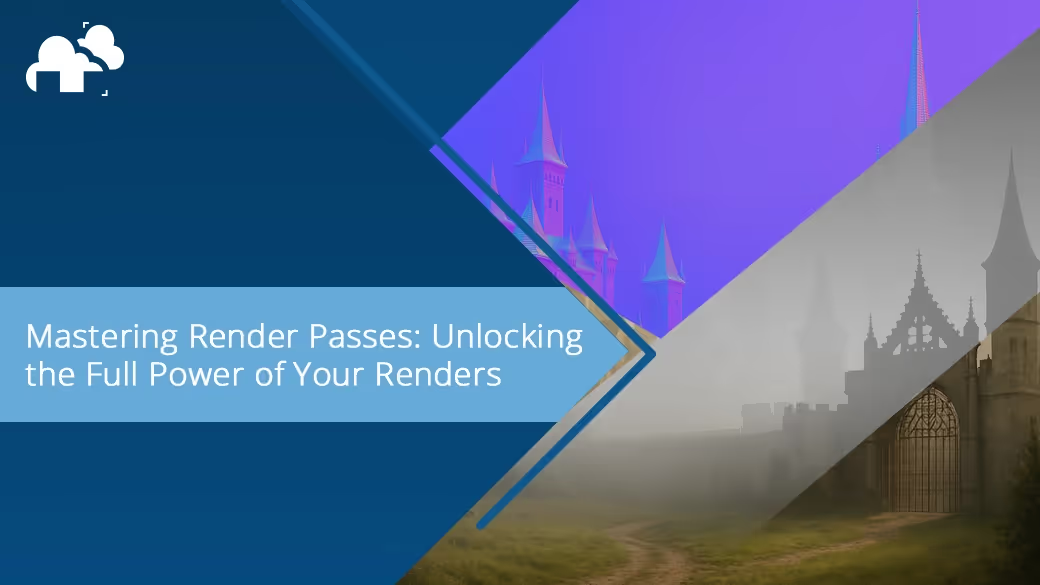
Render passes are an important part of 3D computer graphics as they help break down complex renders into individual layers like shadows, lighting, normals, and more. Because of this, artists now get the ability to fine-tune their images with pinpoint control. If you've ever looked at a cinematic 3D image and wondered how every glint, shadow, or bounce of light feels so intentional, chances are render passes played a big role. In this article, we’ll dive deep into what render passes are, why they matter, and how to leverage them to improve your workflow and elevate the quality of your final output.
In the world of rendering (computer graphics), a render pass refers to an isolated output layer of specific scene information, calculated separately during the rendering process. Instead of creating a single, flattened image, the renderer generates multiple layers of data, each focusing on a specific element like color, shadows, reflections, or normals.
You can essentially think of them as a way to create masks (or as masks themselves) for easier tweaking when editing or post-production. This creates a workflow with great optimization.
Render passes are essential in digital rendering for a number of reasons such as user control and efficiency. In compositing, render passes are the data points that allow for easy and sophisticated manipulation of a scene. Each element such as the shadows, lighting, depth, and more can be tweaked accordingly without having to go back and render an entire scene again. They are an efficient way of rendering and compositing, and can save time and resources due their extreme flexibility for computer generated graphics.
You can modify the color, brightness, contrast, and more of individual passes in post without affecting the whole image. This also adds flexibility when compositing or rendering as you can add or remove visual effects like shadow, depth of field, or reflections after rendering.
With render passes, you can avoid the need to re-render entire scenes for small changes. This makes for shorter turn-arounds and being able to test multiple different things without having to waste more resources on rendering again. Combine, blend, or enhance elements using tools like cryptomatte, masks (computing), and light groups.
There are various render passes that you'll encounter through out rendering. Some of the basic passes include diffuse, specular, normal, shadow, depth, and emission. There are also several others such as gloss and subsurface. For now, let’s explore some of the basic types you’ll encounter in Blender, Maya, and other 3D tools:
Render passes are standard in production pipelines, from big-budget films to indie game projects in 2D computer graphics or real-time tiled rendering workflows.
Render passes lets artists composite CG seamlessly with live-action plates. Studios also split renders into layers such as diffuse, specular, reflection, shadow, and more to give compositors the ability to fine-tune how CGI integrates with live-action footage. This approach lets artists adjust individual lighting contributions or re-balance reflections without re-rendering entire scenes. With separate lighting passes, these tweaks are a matter of layering effects in After Effects or Nuke, or even in real-time rendering software such as Unreal Engine.
In architectural visualization, render passes serve as the foundation for creating photorealistic and emotionally resonant imagery. Visualizers often rely on separate passes such as reflections, shadows, and ambient occlusion to tweak lighting behavior and surface finishes to match real-world references without re-rendering entire environments. For example, depth passes can be used for adding atmospheric perspective or depth-of-field effects, helping to convey spatial relationships more naturally.
Passes allow for stylized, painterly, or abstract post-processing without sacrificing detail. Rather than bake every visual decision into the final render, passes allow for procedural and artistic manipulation. This is especially useful for concept art as tweaking different parts becomes easy, especially when flexibility is crucial with dealing with multiple revisions or even short turn-arounds.
When paired with thoughtful lighting, camera positioning, and material setup, render passes enable a cinematic pipeline similar to real-world photography or cinematography. You can decide how each lighting element contributes to your image and how it interacts with surfaces and space. For example:
Decide which passes you'll need at the start. It saves memory and keeps your render times manageable as you will be thinking less of what should have been, and go straight to editing seamlessly.
Keep your passes organized and clearly labeled for easy manipulation during compositing. This is also especially helpful when working in teams to ensure that everyone understands the project and that the workflow will be as seamless as possible. Proper naming conventions also help in troubleshooting problems during production.
Break down complex scenes with multiple render layers to isolate background, foreground, and effects for maximum flexibility. Having the ability to manipulate each layer makes it easier to make changes and adjustments without having to re-render scenes or go through too much trouble during post-production.
Before rendering at final quality, preview your passes with smaller renders to test your composite setup. You can render your passes at 50 - 70% resolution instead of 100% to check for any mistakes that need to be corrected. This ensures less resources and time being eaten.
Render passes are both a technical overhead and a creative tool. They give you the freedom to experiment, push boundaries, and correct mistakes without re-rendering entire sequences. When paired with a solid understanding of Shader, Light, and camera fundamentals, they unlock the true potential of 3D computer-generated imagery. Like any powerful tool, they take a bit of learning and practice, but the reward is unparalleled control over your images and animations. So next time you hit the render button, think beyond the final image. Think in passes.